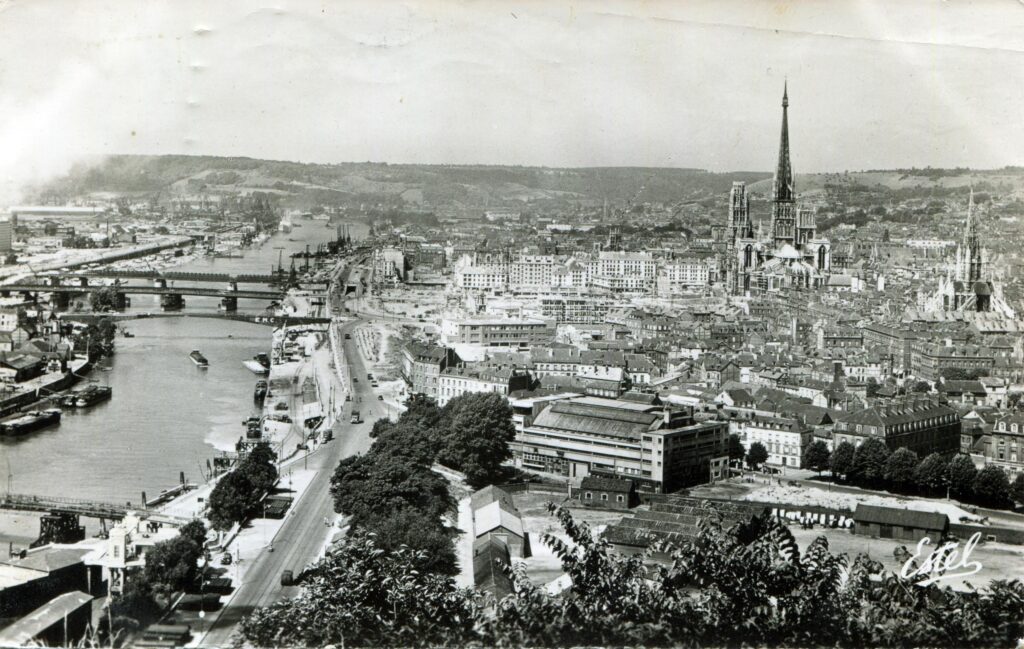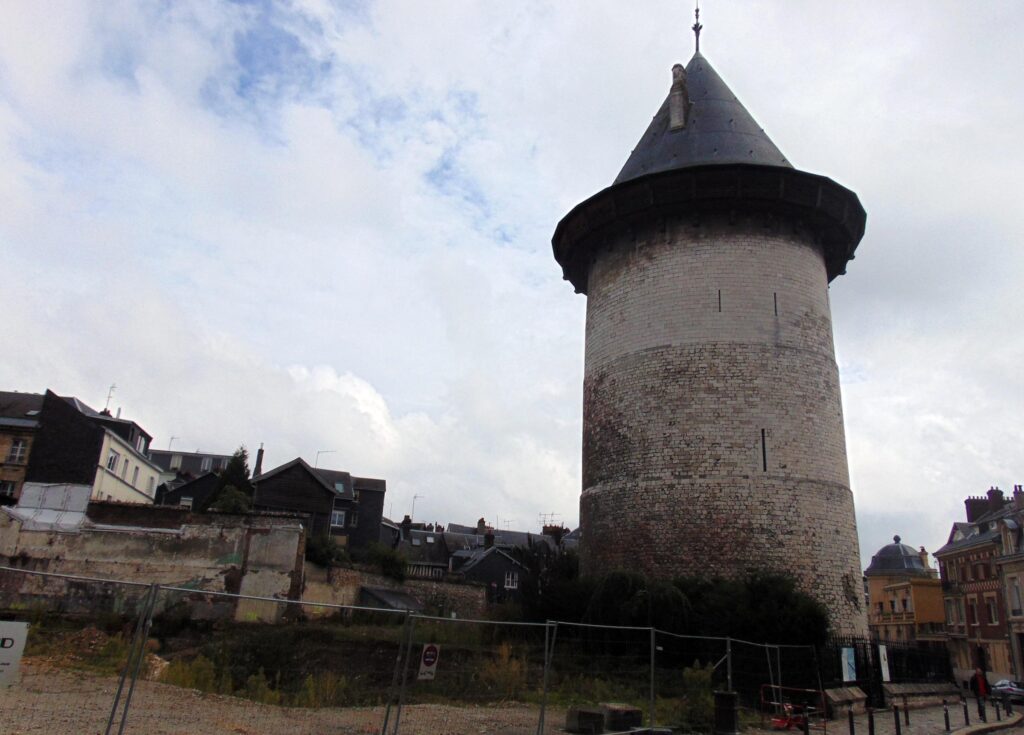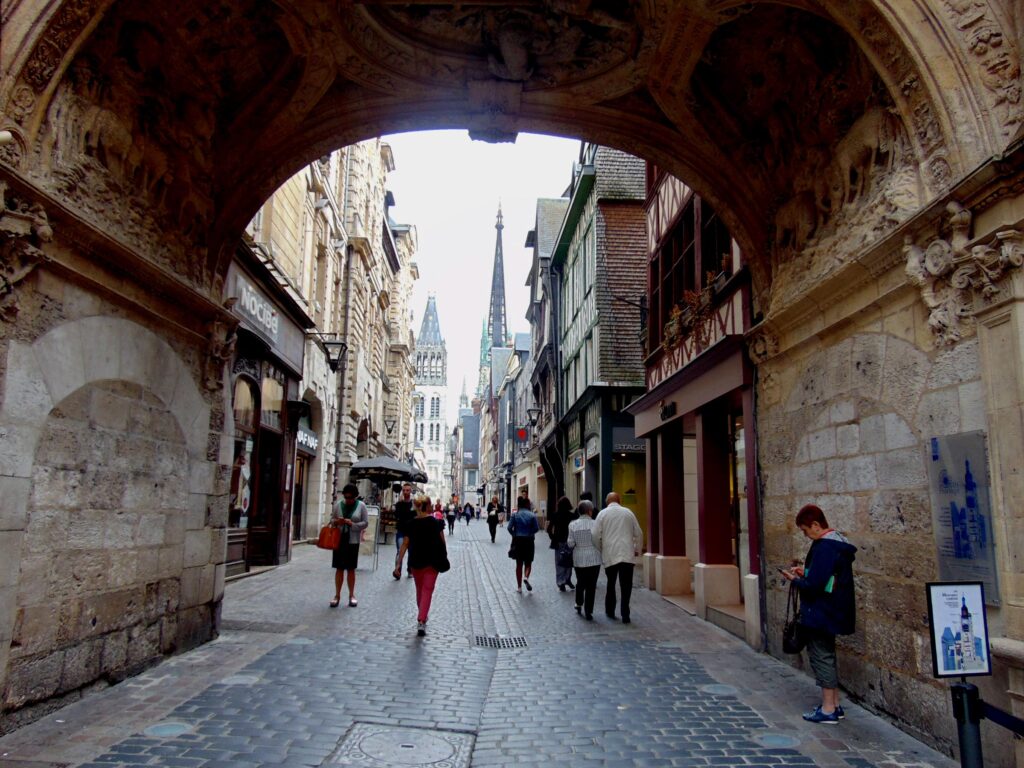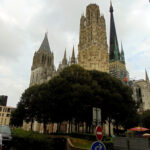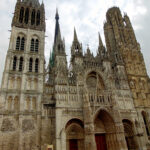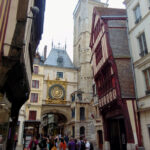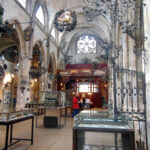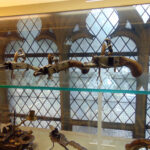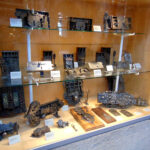Travel Guide to Rouen and the main attractions.
Rouen (French and Norman name) is the historical capital of Normandy, as well as the center of the region and the prefecture of the Seine-Maritime department in northern France. Rouen is a city-museum with ancient buildings, the world-famous Cathedral, churches and collections of fine arts, including in metal. Industrialists, artisans, craftsmen from the Middle Ages…
Rouen, a brief history of the city. Based on archaeological excavations, it is believed that the first settlements here in the 9th millennium BC. End of the first millennium. The Kelian Velikokos tribe founded the fortified settlements of Ratumakos here. In 56-57 years. BC e. the settlement is conquered by the Romans and renamed Rotomagus (Rotomagus)
In 27 BC. e. Rothomagus is part of the Roman province of Lugduna Gaul and plays an important role in the relations of the Roman Republic with the Ocean and the British Isles.
In the III century AD. Rotomagus reaches its maximum development under the Romans. Baths, an amphitheater, a forum with a temple and a monumental fountain are being built.
Second half of the 3rd century. In connection with the invasions of the barbarian tribes, the city is reduced in size and turns into a small military camp. 284-305 The reign of Emperor Diocletian. Rouen becomes the capital of the province of Lugdun Gaul II. IV century. The first Christian cathedral is built in Rouen, and it becomes the residence of the bishop.
V century. The city was captured by the Germanic tribe of the Franks. Rouen becomes the capital of the kingdom of Neustria (the territory of modern northern France, Normandy).
Normandy, the middle ages & Rouen City.
841 The Normans invade the Seine valley, sack and burn Rouen.
843 The division of the empire of Charlemagne, Rouen is part of the West Frankish kingdom. At the end of the ninth – beginning of the tenth centuries, the Normans become sovereign masters of the territory of Upper Normandy.
911 The leader of the Vikings, Rollon, under the terms of the Treaty of Saint-Clair-sur-Ept, receives territory from King Charles the Simple in his possession (the modern region of Upper Normandy) and the status of Count of Rouen
X century. Rouen is the capital of the Duchy of Normandy, as well as a transport hub for Norman trophies, a trading port and a slave market. The Rouans are actively trading with the British and French.
949 Duke of Normandy Richard I (“Fearless”), during the siege of Rouen, fights with the combined troops of King Louis IV of France, Emperor of the Germans Otto the Great and Count of Flanders. The duke’s victory was of great importance for the future of Normandy
1096 Extermination of the Rouen Jews (the largest community in France north of the Loire, due to their negative attitude towards the idea of the First Crusade, proclaimed by Pope Urban II at the end of 1095).
1150 Duke Henry II Plantagenet presents Rouen with a charter of the city – a communal charter. The Council of One Hundred Peers governs, and the inhabitants have united in professional corporations and in the brotherhood of craftsmen. Rouen is the largest trading center selling salt and fish to Paris and wines to England.
1200 Rouen was badly damaged by a major fire; the cathedral will have to be rebuilt, which took several subsequent centuries.
1204 Rouen is captured by the French. King Philip II Augustus of France occupied Rouen on 24 June 1204 after a siege of 40 days. The captain and commandant of Rouen, Pierre de Preo, signed the act of surrender of the city after learning that there would be no help from the Anglo-Norman monarch John.
1204 all Normandy was annexed to the lands of the king of France. The king confirmed the rights and privileges of Rouen, but ordered the destruction of the castle of the dukes and the construction of a castle of Rouen to maintain control over the city. The castle was erected on the site of an ancient Gallo-Roman amphitheater and gave it the name “château Bouvreuil”.
(This castle of Rouen was destroyed in the 15th century and was used as a quarry to obtain stones for construction work. Now only the famous donjon, called the “Tower of Joan of Arc”, was restored with the participation of the architect Viollet-le-Duc. Despite its name, the tower was not the place of imprisonment of Jeanne d’Arc in 1431. Of the tower, where the Virgin of Orleans was actually kept, only the basement has now been preserved, which can be seen by going into the courtyard of house 102 along rue Jeanne-d’Arc.)
In Rouen and its environs (Elbeuf, Darnetal, Barentin, Ville-Ekal, Saint-Pierre-de-Varengeville, Maromme, Le Ulm, Malone, Montville), many textile manufactories appear. Merchants actively buy wool in England, and finished cloth is sold at fairs in Champagne. Rouen’s economy is greatly aided by river trade along the Seine. From the time of King Henry II, Rouen merchants had a monopoly on the navigation of the Seine upstream, all the way to Paris. They shipped wine and wheat to England and bought back wool and tin.
1281 Mass riots in Rouen, caused by dissatisfaction with high taxes. The mayor was killed and the houses of wealthy residents were looted. King Philip IV abolishes the city commune, liquidates the municipality of Rouen and abolishes the monopoly of local merchants on trade along the Seine. However, in 1294 the inhabitants bought back their privileges again.
July 1348 In Rouen, an epidemic of the Black Death plague.
1382 In Rouen, the Garel uprising takes place, ruthlessly suppressed by the royal troops. After that, the authorities raised taxes and canceled the Rouenese privilege to trade on the Seine.
The Hundred Years War and Jeanne d’Arc. On January 19, 1419, during the era of the Hundred Years’ War, Rouen was captured by the troops of the English king Henry V, who annexed Normandy to the lands of the English crown. Henry V died in 1422, and King Charles VI of France also died. Henry V’s brother, John of Lancaster, became regent of France and tried to get the Rouen lands. Becoming a canon of the Rouen Cathedral, he was interred in it, dying in 1435. In Rouen, which was then the center of English power in the territory of the French kingdom, Joan of Arc was tried and executed at the instigation of the Duke of Bedford and the Bourguignon party. On May 30, 1431, the Rouen executioner Geoffrey Terage sent her to the stake. In the same year, the young Henry VI of the Lancaster dynasty was crowned King of France and England in Paris, after which he arrived in Rouen, where he was noisily greeted by a crowd of people. In 1449, the King of France returned Rouen to the French crown, 18 years after the death of Joan of Arc and after 30 years of occupation by the British. Rouen was the religious center of northern France and was the only one in the area with its own archbishop.
Renaissance. At this time, construction resumed in Rouen after the Hundred Years’ War. The construction of the church of Saint-Maclou (Saint-Malo) was completed, the nave of the abbey church of Saint-Ouen was completed, as yet without a facade flanked by two towers. A hall of judicial lobbies was built near the Palace of Justice. The new buildings were built in the flamboyant Gothic style, in which, starting from the 16th century, the first decorative elements of the Renaissance began to be added. Rouen was the fourth most populous after Paris, Marseille and Lyon.
Thanks to the support of the archbishops (Georges Amboise and his nephew Georges II Amboise) and financiers, Rouen was one of the Norman centers of Renaissance art. Architects and artists, such as Roulland Leroy, decorated palaces and mansions in Italian motifs, such as the Bureau of Finances (French: Bureau des Finances), located opposite the gates of the cathedral. The work on the door leaf of the church of Saint-Maclou is attributed to the famous sculptor Jean Goujon.
In November 1468, in order to support and develop the city, Louis XI extended the term of the Rouen fairs (fr. le Pardon Saint-Romain) to six days by royal charter.
The main contribution to the economy of Rouen at the end of the 15th century was made by cloth workshops, as well as silk-weaving studios and metallurgy. The anglers of Rouen reached the shores of Newfoundland and caught cod, and also entered the Baltic Sea to catch herring. Salt came from Portugal and the Atlantic Guerand. Fabrics were sold to Spain, where wool was brought from at that time. The Medici family made Rouen a trading center for Italian potassium alum.
At the beginning of the 16th century, Rouen was the center of trade with Brazil, buying textile dyes there. The workshops used dyes from the New World. Red was obtained from the Brazilian tree, blue – from the indigo plant. The Florentines also chose Rouen as a trading center for the Italian mineral alum in northern France, which was needed to fix the dye on the fabric. The development and extraction of alum at all times, from the Middle Ages to modern times, was exclusively in the monopoly of the Papal Throne.
On October 1, 1550, in Rouen, King Henry II arranged a naumachia, which showed that the ports of Normandy were worthy of becoming the starting point for the development of the South American colonies of the French kingdom.
In 1500, 16 years after the launch of the first printing house in Rouen, 10 printing houses were already operating.
The religious wars
Starting from the 1530s. part of the population of Rouen joined the Reformation movement and became Protestants according to the doctrine preached by John Calvin. They constituted from a quarter to a third of the inhabitants of Rouen, and they were in the position of a minority. In the 1560s, the contradictions between the Catholic and Protestant communities escalated. The Massacre at Vassy marked the beginning of the Wars of Religion in France. On April 15, 1562, the Protestants entered the town hall of Rouen and drove the bails out. In May, the suburbs were gripped by a general struggle against the icons. On May 10, the Catholic parliamentarians left Rouen. The Catholics occupied Fort Saint-Catherine, which dominated the city. Both camps used terror as a means. The authorities of Rouen turned to the Queen of England for help, who, on the basis of an agreement concluded on September 20, 1562 at Hampton Court with Prince Condé, sent troops to support the Protestants. The British occupied Le Havre. On October 26, 1562, French royal troops entered Rouen, plundering the city for three days. At the end of August 1572, news came of the Bartholomew night. To avoid mass reprisals against the Protestants, the city authorities took them into custody. However, from 17 to 20 September, a crowd of people broke down the prison doors and cracked down on the Protestants.
Rouen was repeatedly besieged by Henry IV, but the city resisted, and during the siege from December 1591 to May 1592, the Spanish army under the command of the Duke of Parma came to the aid of Rouen.
In 1515, the permanent Chamber of the Chessboard of Normandy (formed in 1499 in Rouen by Georges d’Amboise) was transformed by King Francis I into Parliament. Parliament remained the governing body in the province until the French Revolution. He had judicial, legislative and executive power in matters relating to Normandy, and his powers exceeded those of the Royal Council. Parliament also had the power to govern French Canada.
In the XVI-XVIII centuries. prosperity was provided by trade in textiles and port activities.
In 1703 the Chamber of Commerce of Normandy was formed.
In 1734, a surgical school was opened, the second in France after Paris (1724).
In 1758, a new city hospital was opened in the west of Rouen, which replaced the old hospital, located south of the cathedral, which was too small.
In 1790 the city becomes the administrative center of the Lower Seine department.
Normandy. The Modern history
During the war of 1870, Rouen was occupied by Prussian troops, who quartered on January 9, 1871. 1896 The French National and Colonial Exhibition was held in Rouen. Its attraction was the “village nègre” (Negro village), built on the Champ de Mars. “Different worlds of distant lands were united around a small lake where pies made of whole trees floated, and where all day long many Negro children dived in search of coins thrown by visitors,” wrote the exhibition almanac. The public and the press were fascinated by this primitive society; the exhibition was visited by 600,000 guests.
World War I: During the First World War, a British military base was located in Rouen.
World War II battles and Normandy
During the Second World War, Rouen, after a heroic defense, was occupied by German troops (from June 9, 1940 to August 30, 1944). During the defense in June 1940 there was a big fire that destroyed the entire historic quarter between the cathedral and the Seine. He received heavy damage during the Allied bombing of Normandy from 1942 to 1944, when the bridges over the Seine and the marshalling yard at Sotteville-le-Rouen were the targets of destruction.
On April 19, 1944, two air raids were made, which caused the most casualties, when 816 local residents were killed and 20,000 were injured from RAF air strikes, Rouen Cathedral and the Palace of Justice were badly damaged. There were partisans and underground fighters participating in the resistance movement in the city.
from May 30 to June 5, 1944, Rouen was bombed by the Americans, and this week went down in history as “Red Week”; from this bombing in Rouen, the cathedral and the historic quarter adjacent to it burned again. After the war, the center was restored and reconstructed for 15 years according to the project of the French architect Jacques Grebe. The memory of the Second World War is immortalized by many memorial plaques.
Rouen, the main attractions, what to see
Rouen has preserved entire blocks of medieval streets in their historical form, especially in the center. The main attraction is Rouen Cathedral, the construction of which began in 1210 and lasted for about three centuries. During this period, the architecture of the building absorbed the main features of various styles, with the dominant Gothic.
The central tower of the cathedral was built in the 19th century and reaches a height of 151 m. It is considered the highest in France. Rouen Cathedral is immortalized by the famous impressionist Claude Monet in his series of paintings with landscapes (he painted the cathedral for two and a half years, in total 31 paintings and 47 sketches were obtained from different angles and lighting). During a tour of the cathedral, you can see his paintings on the walls.
- The view of Rouen Cathedral from the north side
- decorations of the Cathedral from the front
The Benedictine church of Sainte-Ouen, famous for its Cavaillé-Coll organ, features 14th-century Gothic stained-glass windows.
The Church of Saint-Maclou is an excellent example of the Flamboyant Gothic style. On the left side of the church there is a fountain similar to the “Manneken Pis”, quite unexpected for such a place.
Behind the Church of St. Maclou is another local attraction – the cemetery of Saint-Maclo. The square arch opens the entrance to the square courtyard where concerts are held. There is a cross in the center of the square.
The astronomical clock is one of the symbols of the city, its calling card. Located on the Renaissance gate Gros-Horloge. The watch has only an hour hand, which ends with a golden ram. Its extended front leg tells the time. This symbolizes that Rouen made a fortune in wool processing. The city’s official coat of arms also features a ram. The clock mechanism is one of the oldest in Europe.
- beautiful buildings in the center of Rouen
A silver ball above the dial shows the phase of the moon, which was once important for astrological forecasts, agriculture and navigation. A sector is cut out under the dial, which indicates the days of the week with changing pictures.
Next to the clock rises the bell tower of the XIV century. The Gothic tower, the classical style fountain and the Renaissance gate are a mixture of art and different eras.
Sights in the form of civil buildings built in the Middle Ages have been preserved in the historical center. These are the Renaissance mansion of Burteruld, half-timbered houses of wealthy citizens and the Gothic Palace of Justice.
Museums of Rouen:
– Museum of Fine Arts.
Here you can get acquainted with the collection of works of the Impressionists.
– Museum of fine ironwork “Le Secq des Tournelles”
The collection of fine art in metal, located in the building of an old church, contains a collection of jewelry and fine art made of metal, unique in the world. Keys, locks, tools and even antique weapons.
- Museum of Fine Iron Art
- Artistic weapons, flintlock pistols
- Original artistic keys and locks with a secret
Shopping, the flea markets, souvenirs
Market place Saint-Marc. It sells local farm products from Normandy, as well as antiques, crockery and home furnishings.
Old market (“Vieux Marche”). Great place for gourmets. There is a large selection of the famous cheeses of Normandy. Meat products, delicacies and sweets.
Tourists love to buy the famous blue and white pottery, reminiscent of Chinese style. There were 22 factories in and around Rouen, the most famous being Bertin, Mouchard Caussy and Guillibaud. Ceramic products are also made in craft workshops on Rue Saint-Romain, near the cathedral. Here you can look at the masters at work and buy your favorite ceramic items.
French cuisine, the best restaurants and cafes.
The local “signature” dish is Rouen duck. It is difficult to prepare, but tasty: first it is smeared with mustard, then it is fried on a grill or skewer in front of the customer. The duckling is served with a sauce based on shallots and Bordeaux wines, with a baked apple and celery.
Rouen is also famous for apple dishes: baked apples, apple pies with juice, cider, calvados and other alcoholic drinks made from apple juice. Delicious chocolates, sweets and desserts.
There are many restaurants and cafes in the city where you can try all this.
The best hotels.
Practical information, how to visit.
Normandy sightseeing tours from Paris
- Private Normandy tours from Paris or Charles de Gaulle airport by a car

